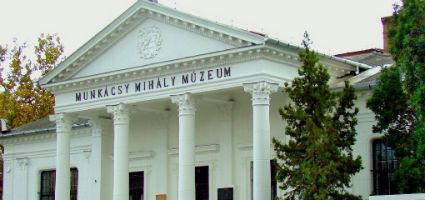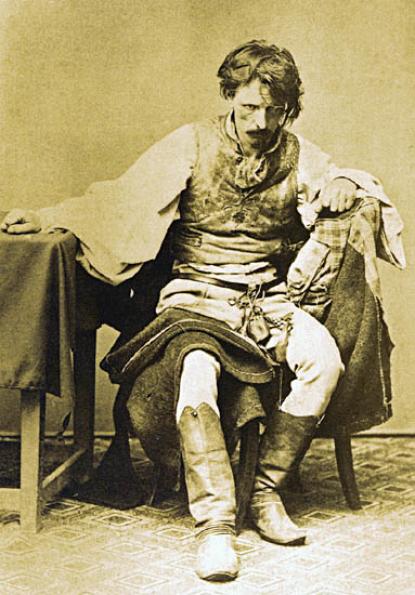2024. April 28. Sunday
Mihály Munkácsy Museum - Békéscsaba
 |
Address: 5600, Békéscsaba Széchenyi u. 9.
Phone number: (66) 323-377, (66) 328-040
E-mail: mmm@bmmi.hu
Opening hours: Tue-Sun 10-18
|
The exhibition has closed for visitors.
2004.04.01. - 2004.06.30.
Museum tickets, service costs:
|
Individual ticket for adults
(valid for the permanent exhibitions)
|
800 HUF
|
/ capita
|
|
Individual ticket for adults
(valid for the 1 temporal exhibition)
|
400 HUF
|
/ capita
|
|
Individual ticket for adults
(valid for 2 temporal exhibitions)
|
600 HUF
|
/ capita
|
|
Individual ticket for adults
(valid for the permanent exhibitions + 2 temporal exhibitions)
|
1000 HUF
|
/ capita
|
|
Individual ticket for adults
|
400 HUF
|
/ capita
|
|
Individual ticket for adults
|
200 HUF
|
/ capita
|
|
Individual ticket for adults
|
300 HUF
|
/ capita
|
|
Individual ticket for adults
|
500 HUF
|
/ capita
|
|
Group ticket for adults
(valid for the permanent exhibitions, over 10 people)
|
500 HUF
|
/ capita
|
|
Individual ticket for students
(under 26 years of age, valid for the permanent exhibitions)
|
400 HUF
|
/ capita
|
|
Individual ticket for students
(under 26 years of age, valid for the 1 temporal exhibition)
|
200 HUF
|
/ capita
|
|
Individual ticket for students
(under 26 years of age, valid for 2 temporal exhibitions)
|
300 HUF
|
/ capita
|
|
Individual ticket for students
(under 26 years of age, valid for the permanent exhibitions + 2 temporal exhibitions)
|
500 HUF
|
/ capita
|
|
Group ticket for students
(valid for the permanent exhibitions, over 10 people)
|
350 HUF
|
/ capita
|
|
Individual ticket for pensioners
(valid for the permanent exhibitions)
|
400 HUF
|
/ capita
|
|
Individual ticket for pensioners
(valid for the 1 temporal exhibition)
|
200 HUF
|
/ capita
|
|
Individual ticket for pensioners
(valid for 2 temporal exhibitions)
|
300 HUF
|
/ capita
|
|
Individual ticket for pensioners
(valid for the permanent exhibitions + 2 temporal exhibitions)
|
500 HUF
|
/ capita
|
|
Ticket for families
(valid for the 1 temporal exhibition)
|
800 HUF
|
/ family
|
|
Ticket for families
(valid for 2 temporal exhibitions)
|
1000 HUF
|
/ family
|
|
Ticket for families
(valid for the permanent exhibitions + 2 temporal exhibitions)
|
2000 HUF
|
/ family
|
|
Individual ticket for families
(valid for the permanent exhibitions)
|
1500 HUF
|
/ family
|
|
Group guide
(valid for all exhibitions, up to 25 people, on prior notice, over the ticket )
|
1000 HUF
|
/ group
|
|
Group guide
(valid for all exhibitions, over 25 people, on prior notice, over the ticket )
|
100 HUF
|
/ capita
|
|
Group guide
(valid for all exhibitions, up to 25 people, on prior notice, over the ticket )
|
5000 HUF
|
/ group
|
|
Group guide
(valid for all exhibitions, up to 25 people, on prior notice, over the ticket )
|
200 HUF
|
/ capita
|
|
Group guide for adults
(valid for 3 permanent exhibition: "Pro Natura" + "Munkácsy memorial room" + "Archeological Exhibition" or "Affluence - Ethnography Exhibition", up to 25 people, on prior notice)
|
3000 HUF
|
/ group
|
|
Group guide for adults
(valid for 3 permanent exhibition: "Pro Natura" + "Munkácsy memorial room" + "Archeological Exhibition" or "Affluence - Ethnography Exhibition", over 25 people, on prior notice)
|
150 HUF
|
/ capita
|
|
Audio guide
|
100 HUF
|
/ capita
|
Mihály Munkácsy lived at exciting times when a lot of innovations occurred. At the beginning of the 19th century the renewal of painting was in connection with photography. One of our first photographers was Antal Simonyi who studied in Paris. He and Lieb-Munkácsy met in 1863. The first portraits of Munkácsy was made by him and another photo artist who had also been a painter earlier, József Borsos. Since the models were expensive eased the lonf process of painting by way of taking photos first. The paintings titled: 'The Battle Field of Isaszeg' and the 'Inviters to the Wedding' were first pictured on photographs.

Munkácsy worked in Düsseldorf from 1868, close to L. Kraus. He painted the 'Yawning Boy' and the 'Death Row', which was preceded by almost ten photo studies of the characters. The studies prove that the young painter designed the compositions of his pictures with a lot of care. He organized his models, directed them, in one word: he created them.
Munkácsy lived in Paris, the center of photography, from 1872. Painting and architecture went through revolutionary changes at this time. Munkácsy was connected to photography on many different levels. One of the men who helped him was his neighbor, G. Doré. He was one of the permanent figures in the events of photography in the middle of the 19th century. Munkácsy had pictures taken of him and his wife, Cecil in the most important studios of Paris. His journeys were documented by his friends and they did the pictures for his paintings as well.
There is a photo with 20 people made as a study for the painting 'Christ in front of Pilate'. This picture suggest the idea of presenting the mob the painter later paint. The dressed up models were staged as if they were performing a theatre play, with emphasizing the balances. There are two photo studies to the 'Golgota' in the Museum of Békéscsaba. On one of them there are two arguing Pharisies, on the other the main character appears. The model photo was taken of Munkácsy, he himself tied himself to the cross to identify with the bodily and spiritual pain of being crucified.
The exhibition presents the life, environment, and cult of Munkácsy through the photos of events. The model photos let the visitors take an insight into the process of creation, they designate the journey of the artist from the first studies to the ready painting. Beside the oeuvre of Munkácsy we may also peep into the photos of Germany, France, Luxemburg, and Hungary. The pictures show the development of the technique of the photos. The exhibition is a good example of the codependence of photography and painting.
Sz. Katalin Kürti

Munkácsy worked in Düsseldorf from 1868, close to L. Kraus. He painted the 'Yawning Boy' and the 'Death Row', which was preceded by almost ten photo studies of the characters. The studies prove that the young painter designed the compositions of his pictures with a lot of care. He organized his models, directed them, in one word: he created them.
Munkácsy lived in Paris, the center of photography, from 1872. Painting and architecture went through revolutionary changes at this time. Munkácsy was connected to photography on many different levels. One of the men who helped him was his neighbor, G. Doré. He was one of the permanent figures in the events of photography in the middle of the 19th century. Munkácsy had pictures taken of him and his wife, Cecil in the most important studios of Paris. His journeys were documented by his friends and they did the pictures for his paintings as well.
There is a photo with 20 people made as a study for the painting 'Christ in front of Pilate'. This picture suggest the idea of presenting the mob the painter later paint. The dressed up models were staged as if they were performing a theatre play, with emphasizing the balances. There are two photo studies to the 'Golgota' in the Museum of Békéscsaba. On one of them there are two arguing Pharisies, on the other the main character appears. The model photo was taken of Munkácsy, he himself tied himself to the cross to identify with the bodily and spiritual pain of being crucified.
The exhibition presents the life, environment, and cult of Munkácsy through the photos of events. The model photos let the visitors take an insight into the process of creation, they designate the journey of the artist from the first studies to the ready painting. Beside the oeuvre of Munkácsy we may also peep into the photos of Germany, France, Luxemburg, and Hungary. The pictures show the development of the technique of the photos. The exhibition is a good example of the codependence of photography and painting.
Sz. Katalin Kürti
